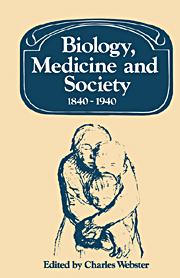Book contents
- Frontmatter
- Contents
- Contributors
- Preface and Acknowledgements
- Introduction
- 1 Women's Health and the Women's Movement in Britain: 1840–1940
- 2 Working-Class Mothers and Infant Mortality in England, 1895–1914
- 3 Theories of the Cell State in Imperial Germany
- 4 Innate Character in Animals and Man: A Perspective on the Origins of Ethology
- 5 Genetics in the United States and Great Britain 1890–1930: A Review with Speculations
- 6 Eugenics and Class
- 7 Sociobiologies in Competition: The Biometrician–Mendelian Debate
- 8 Psychologists and Class
- 9 Measuring Intelligence: English Local Education Authorities and Mental Testing 1919–1939
- Index
7 - Sociobiologies in Competition: The Biometrician–Mendelian Debate
Published online by Cambridge University Press: 02 December 2009
- Frontmatter
- Contents
- Contributors
- Preface and Acknowledgements
- Introduction
- 1 Women's Health and the Women's Movement in Britain: 1840–1940
- 2 Working-Class Mothers and Infant Mortality in England, 1895–1914
- 3 Theories of the Cell State in Imperial Germany
- 4 Innate Character in Animals and Man: A Perspective on the Origins of Ethology
- 5 Genetics in the United States and Great Britain 1890–1930: A Review with Speculations
- 6 Eugenics and Class
- 7 Sociobiologies in Competition: The Biometrician–Mendelian Debate
- 8 Psychologists and Class
- 9 Measuring Intelligence: English Local Education Authorities and Mental Testing 1919–1939
- Index
Summary
The years around 1900 witnessed a bitter controversy within British biology. It involved on the one hand the biometricians, or biometric school, led by the statistician and philosopher Karl Pearson (1857–936) and the zoologist W. F. R. Weldon (1860–1906), and on the other, the early Mendelian geneticists led by William Bateson (1861–1926). The controversy was marked by the shattering of personal friendships, by heated public debate, by suggestions of fraud and by long-lasting divisions within the British scientific community. Historians of biology have rightly identified the episode as an important one in the development of modern genetics and evolutionary theory, and accordingly it has been the object of considerable scholarly attention, particularly in the last decade.
My aim here is neither to produce another account of the events of the controversy nor to discuss its long-term significance. Rather it is to ask a somewhat different question from those that have hitherto been raised in the bulk of the literature on the controversy. I shall inquire as to the extent to which the controversy can be seen as sustained by social factors. I shall examine both the role of factors arising from the ‘internal’ social structure of science and the way in which the controversy was connected to society at large by the ‘sociobiological’ uses of the theories of genetics and evolution. First, however, it is necessary to discuss the most obvious issue on which the two sides differed: their approaches to the study of heredity.
GREEN PEAS, YELLOW PEAS AND GREENISHYELLOW PEAS
- Type
- Chapter
- Information
- Biology, Medicine and Society 1840–1940 , pp. 243 - 288Publisher: Cambridge University PressPrint publication year: 1981
- 10
- Cited by

